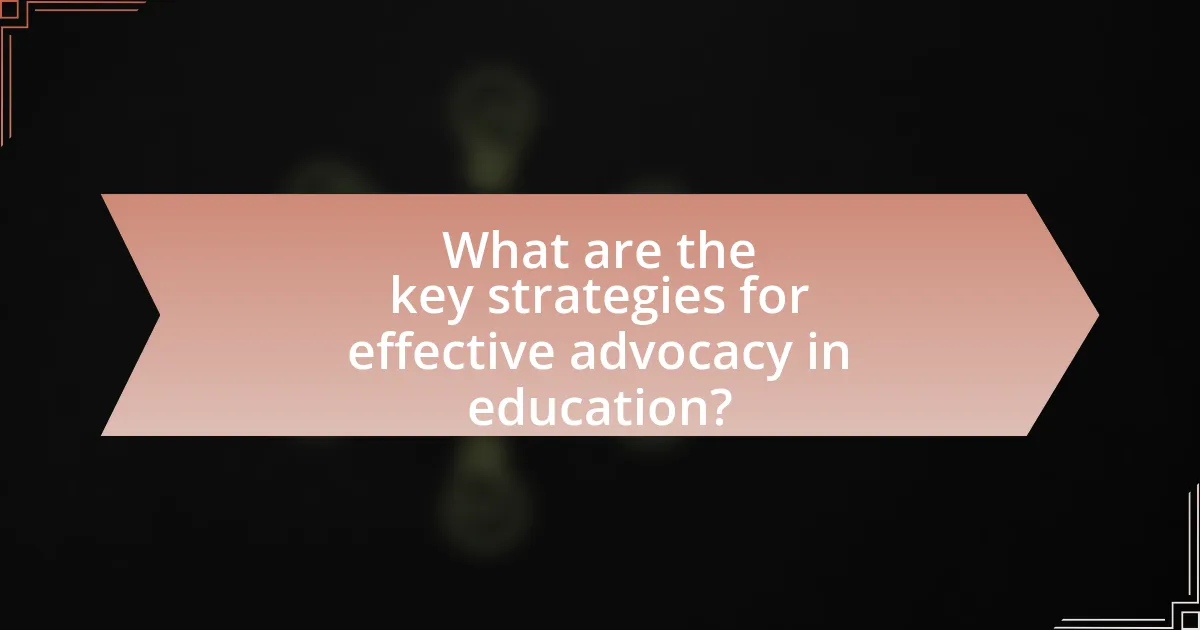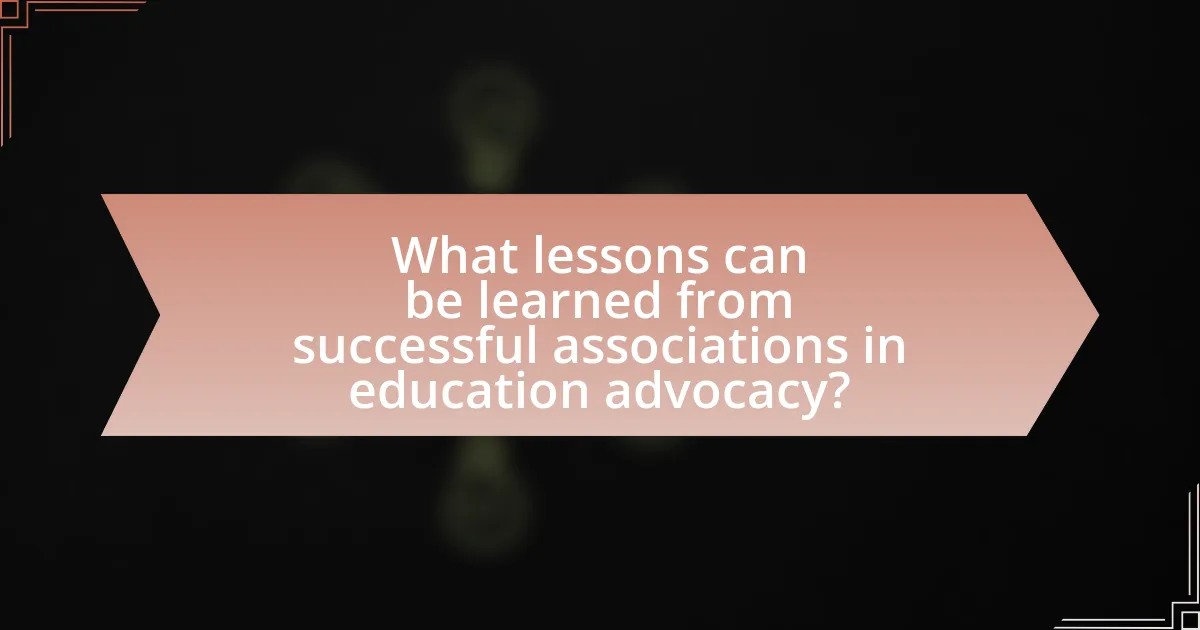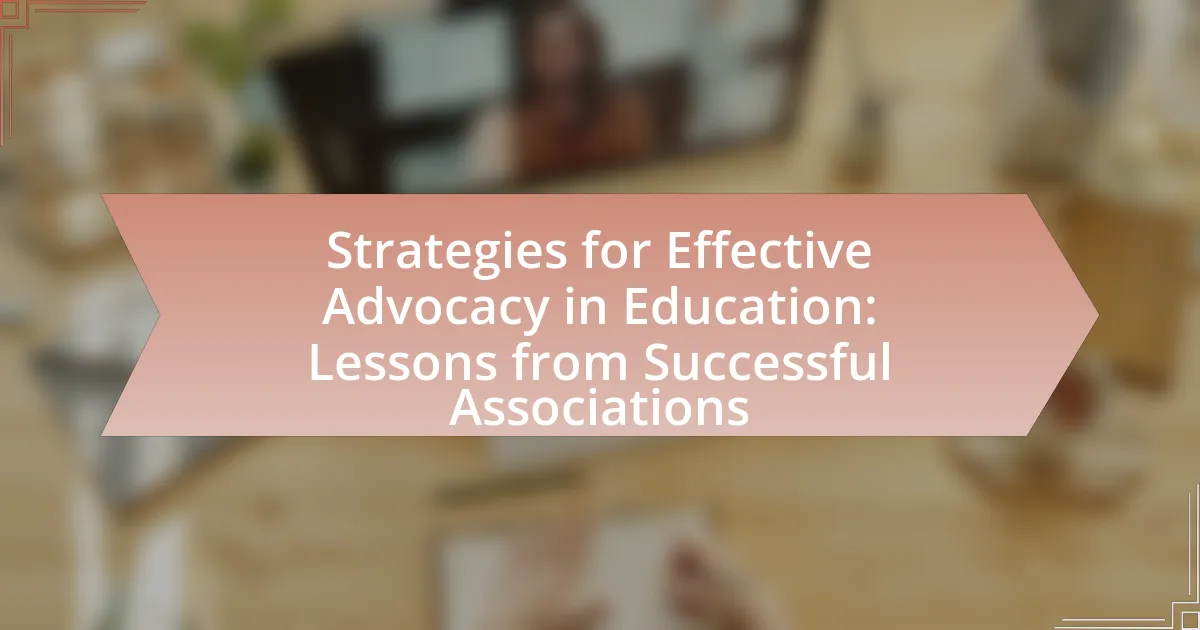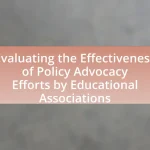The article focuses on key strategies for effective advocacy in education, highlighting the importance of building strong coalitions, utilizing data-driven arguments, and engaging stakeholders through clear communication. It examines how successful associations implement these strategies by establishing clear goals, mobilizing stakeholders, and leveraging data to inform their advocacy efforts. Additionally, the article discusses specific tactics for engaging stakeholders, measuring advocacy effectiveness, and the impact of advocacy on educational policies and funding. It also outlines best practices for emerging associations and practical steps for implementing advocacy strategies in the education sector.

What are the key strategies for effective advocacy in education?
Key strategies for effective advocacy in education include building strong coalitions, utilizing data-driven arguments, and engaging stakeholders through clear communication. Strong coalitions enhance advocacy efforts by uniting diverse groups, which can amplify influence and resources. Data-driven arguments are essential as they provide concrete evidence to support claims, making the case for educational reforms more compelling; for instance, studies show that schools with higher funding levels correlate with improved student outcomes. Engaging stakeholders, including parents, teachers, and community members, through clear and consistent communication fosters a sense of ownership and collaboration, which is crucial for successful advocacy initiatives.
How do successful associations implement these strategies?
Successful associations implement advocacy strategies by establishing clear goals, engaging stakeholders, and utilizing data-driven approaches. They define specific objectives that align with their mission, ensuring that all efforts are focused and measurable. For example, the National Education Association (NEA) effectively mobilizes its members by setting legislative priorities that reflect the needs of educators and students.
Additionally, successful associations actively engage stakeholders, including educators, parents, and policymakers, to build coalitions and foster collaboration. The American Federation of Teachers (AFT) exemplifies this by organizing grassroots campaigns that involve community members in advocacy efforts, thereby amplifying their voice and influence.
Moreover, these associations leverage data to inform their strategies, using research and statistics to support their positions and persuade decision-makers. For instance, the National Association of Secondary School Principals (NASSP) utilizes data on student outcomes to advocate for policies that enhance educational quality. This combination of goal-setting, stakeholder engagement, and data utilization enables successful associations to effectively implement their advocacy strategies.
What specific tactics do they use to engage stakeholders?
Successful associations engage stakeholders through targeted communication, collaborative partnerships, and data-driven advocacy. They utilize regular updates via newsletters and social media to keep stakeholders informed and involved. Collaborative partnerships with other organizations enhance their reach and influence, allowing for shared resources and joint initiatives. Data-driven advocacy involves presenting research and statistics to support their positions, thereby making a compelling case for their initiatives. For instance, the National Education Association often uses surveys and reports to highlight the needs of educators, which strengthens their advocacy efforts and stakeholder engagement.
How do they measure the effectiveness of their advocacy efforts?
They measure the effectiveness of their advocacy efforts through a combination of quantitative and qualitative metrics. Quantitative metrics often include tracking changes in policy outcomes, such as the number of legislative bills passed or amendments adopted that align with their advocacy goals. Qualitative metrics may involve gathering feedback from stakeholders, assessing public awareness levels, and evaluating shifts in community attitudes towards educational issues. For instance, successful associations often conduct surveys before and after campaigns to gauge changes in public perception, providing concrete data that demonstrates the impact of their advocacy initiatives.
Why is advocacy important in the education sector?
Advocacy is important in the education sector because it influences policy decisions that affect educational quality and access. Effective advocacy ensures that the voices of educators, students, and communities are heard, leading to the implementation of policies that promote equitable resources and support. For instance, research by the National Education Association highlights that advocacy efforts have resulted in increased funding for public schools, demonstrating the tangible impact of organized efforts on educational outcomes.
What impact does advocacy have on educational policies?
Advocacy significantly influences educational policies by shaping public opinion, mobilizing stakeholders, and driving legislative change. For instance, organizations like the National Education Association have successfully lobbied for increased funding and equitable access to education, resulting in policy reforms that address disparities in educational resources. Research shows that advocacy efforts can lead to the implementation of policies that reflect the needs and voices of educators and communities, thereby enhancing the overall effectiveness of educational systems.
How does advocacy influence funding and resources for education?
Advocacy significantly influences funding and resources for education by mobilizing public support and shaping policy decisions. When advocacy groups effectively communicate the needs and benefits of educational initiatives, they can attract attention from policymakers and stakeholders, leading to increased financial support. For instance, the National Education Association reported that successful advocacy campaigns have resulted in billions of dollars in additional funding for public schools across various states. This demonstrates that organized efforts to highlight educational issues can directly impact the allocation of resources, ultimately enhancing educational opportunities.

What lessons can be learned from successful associations in education advocacy?
Successful associations in education advocacy demonstrate the importance of collaboration, strategic communication, and data-driven approaches. These associations often achieve their goals by uniting diverse stakeholders, including educators, parents, and policymakers, to create a unified voice that amplifies their message. For instance, the National Education Association (NEA) effectively mobilizes its members to advocate for policies that benefit public education, showcasing the power of collective action. Additionally, successful associations utilize clear and compelling narratives supported by research and statistics to influence public opinion and legislative decisions. The American Association of Colleges for Teacher Education (AACTE) emphasizes the need for evidence-based advocacy, which has proven effective in securing funding and policy changes that support teacher education programs. These lessons highlight the critical role of collaboration, effective communication, and reliance on data in successful education advocacy efforts.
What are some notable case studies of effective advocacy?
Notable case studies of effective advocacy include the American Federation of Teachers (AFT) campaign for increased teacher salaries and improved working conditions, which successfully mobilized educators and garnered public support, leading to significant policy changes in several states. Another example is the National Education Association (NEA) initiative to promote equitable funding for public schools, which utilized data-driven arguments and grassroots organizing to influence legislation, resulting in increased funding allocations in multiple districts. These case studies demonstrate the power of collective action and strategic communication in achieving advocacy goals within the education sector.
What strategies did these associations employ to achieve their goals?
These associations employed strategies such as coalition building, targeted communication, and grassroots mobilization to achieve their goals. Coalition building involved forming alliances with other organizations to amplify their advocacy efforts, thereby increasing their influence and reach. Targeted communication included crafting specific messages tailored to different stakeholders, ensuring that their objectives resonated with policymakers and the public. Grassroots mobilization engaged members and supporters in advocacy campaigns, leveraging their collective voice to push for educational reforms. These strategies have been proven effective in various case studies, demonstrating their impact on policy changes and educational improvements.
What challenges did they face and how did they overcome them?
Successful associations in education faced challenges such as limited funding, resistance to change, and lack of stakeholder engagement. They overcame these obstacles by implementing strategic fundraising initiatives, fostering collaborative relationships with key stakeholders, and utilizing data-driven advocacy to demonstrate the impact of their proposals. For instance, associations often organized community outreach programs to raise awareness and secure financial support, which helped to build a stronger coalition for their advocacy efforts. Additionally, they engaged in continuous dialogue with policymakers to address resistance and align their goals with the interests of the educational community.
How do these lessons apply to new advocacy efforts?
The lessons from successful associations in education advocacy apply to new advocacy efforts by providing a framework for effective communication, coalition-building, and strategic planning. For instance, successful associations emphasize the importance of data-driven arguments, which can enhance credibility and persuade stakeholders. Research shows that advocacy efforts backed by solid evidence, such as statistics on educational outcomes, are more likely to influence policy decisions. Additionally, these associations demonstrate the value of building diverse coalitions, which can amplify voices and broaden support for initiatives. By adopting these strategies, new advocacy efforts can increase their impact and effectiveness in driving educational change.
What best practices can be adopted by emerging associations?
Emerging associations can adopt best practices such as establishing clear goals, engaging members actively, and leveraging technology for communication. Clear goals provide direction and measurable outcomes, which are essential for assessing progress and effectiveness. Active member engagement fosters a sense of community and encourages participation, which is crucial for advocacy efforts. Leveraging technology, such as social media and online platforms, enhances outreach and facilitates real-time communication, allowing associations to mobilize support quickly. These practices are supported by successful associations that have demonstrated increased member retention and advocacy impact through structured goal-setting, member involvement, and effective use of digital tools.
How can new advocates avoid common pitfalls in their efforts?
New advocates can avoid common pitfalls by thoroughly researching their issues and understanding the landscape of advocacy. This foundational knowledge helps them identify key stakeholders, potential allies, and opposition, which is crucial for effective strategy development. For instance, a study by the National Education Association highlights that successful advocates often engage in comprehensive stakeholder analysis, allowing them to tailor their messages and approaches effectively. Additionally, new advocates should seek mentorship from experienced professionals in the field, as guidance can help them navigate challenges and avoid missteps that could derail their efforts.

What are the practical steps for implementing advocacy strategies in education?
The practical steps for implementing advocacy strategies in education include identifying key issues, building coalitions, developing a clear message, engaging stakeholders, and utilizing various communication channels. Identifying key issues involves assessing the specific educational challenges that need advocacy, such as funding, policy changes, or curriculum improvements. Building coalitions with like-minded organizations enhances the strength of the advocacy effort, as seen in successful campaigns by groups like the National Education Association, which collaborates with various stakeholders to amplify their voice.
Developing a clear message ensures that the advocacy efforts are focused and resonate with the target audience, which is crucial for effective communication. Engaging stakeholders, including teachers, parents, and community members, fosters a sense of ownership and support for the advocacy initiatives. Utilizing various communication channels, such as social media, newsletters, and community meetings, allows for broader outreach and engagement, as demonstrated by successful advocacy campaigns that leverage multiple platforms to reach diverse audiences.
How can educators and advocates build effective coalitions?
Educators and advocates can build effective coalitions by establishing clear goals, fostering open communication, and leveraging diverse expertise. Clear goals align the coalition’s efforts and provide a shared vision, which is essential for collaboration. Open communication ensures that all members feel valued and informed, facilitating trust and cooperation. Additionally, leveraging diverse expertise allows coalitions to address complex educational issues more comprehensively, drawing on the strengths of various stakeholders. Research indicates that coalitions with diverse membership are more successful in achieving their objectives, as they can mobilize a wider range of resources and perspectives.
What roles do collaboration and partnerships play in advocacy?
Collaboration and partnerships are essential in advocacy as they enhance resource sharing, amplify voices, and increase the impact of initiatives. By working together, organizations can pool their expertise, funding, and networks, leading to more comprehensive and effective advocacy strategies. For instance, coalitions formed by educational associations have successfully influenced policy changes by presenting a united front, demonstrating that collective action can lead to significant outcomes, such as the passage of legislation that benefits educational systems. Research shows that collaborative advocacy efforts can result in a 30% higher success rate in achieving policy goals compared to isolated efforts, highlighting the critical role that partnerships play in driving meaningful change in education.
How can technology enhance advocacy efforts in education?
Technology can enhance advocacy efforts in education by facilitating communication, increasing access to information, and enabling data-driven decision-making. For instance, digital platforms allow educators and advocates to connect with stakeholders, share resources, and mobilize support quickly and efficiently. According to a report by the National Education Association, 75% of educators believe that technology improves their ability to advocate for their students’ needs. Additionally, data analytics tools can help identify trends and measure the impact of advocacy initiatives, providing concrete evidence to support policy changes. This integration of technology not only streamlines advocacy efforts but also empowers educators to make informed decisions based on real-time data.
What resources are available for advocates in education?
Advocates in education have access to various resources, including professional organizations, online platforms, and training programs. Professional organizations such as the National Education Association (NEA) and the American Federation of Teachers (AFT) provide advocacy tools, research, and networking opportunities. Online platforms like Edutopia and Education Week offer articles, webinars, and forums for sharing best practices. Additionally, training programs, such as those offered by the National Association of School Psychologists (NASP), equip advocates with skills in policy advocacy and community engagement. These resources collectively enhance the effectiveness of advocacy efforts in the education sector.
What tools and platforms can assist in advocacy campaigns?
Tools and platforms that can assist in advocacy campaigns include social media platforms, email marketing services, and advocacy software. Social media platforms like Facebook and Twitter enable organizations to reach a broad audience quickly, facilitating engagement and mobilization. Email marketing services such as Mailchimp allow for targeted communication, helping to inform supporters and encourage action. Advocacy software like NationBuilder and EveryAction provides tools for organizing campaigns, managing contacts, and tracking engagement, which enhances the effectiveness of advocacy efforts. These tools collectively support the strategic goals of advocacy campaigns by improving outreach, engagement, and organization.
How can advocates access training and support networks?
Advocates can access training and support networks through various organizations and platforms dedicated to advocacy in education. These organizations often provide workshops, webinars, and resources tailored to enhance advocacy skills and knowledge. For instance, the National Education Association (NEA) offers professional development programs that equip advocates with effective strategies and tools. Additionally, online platforms like the Advocacy Institute provide access to a range of training materials and networking opportunities, allowing advocates to connect with peers and experts in the field. These resources are essential for building a robust support network and improving advocacy efforts in education.
What are the top tips for successful advocacy in education?
The top tips for successful advocacy in education include building strong relationships, understanding the policy landscape, and effectively communicating your message. Building relationships with stakeholders, such as educators, parents, and policymakers, fosters collaboration and support for educational initiatives. Understanding the policy landscape involves researching current laws and regulations, which enables advocates to identify opportunities for influence. Effective communication of your message ensures clarity and persuasiveness, utilizing data and personal stories to resonate with the audience. These strategies are supported by successful advocacy efforts that have led to significant educational reforms and funding increases in various regions.


